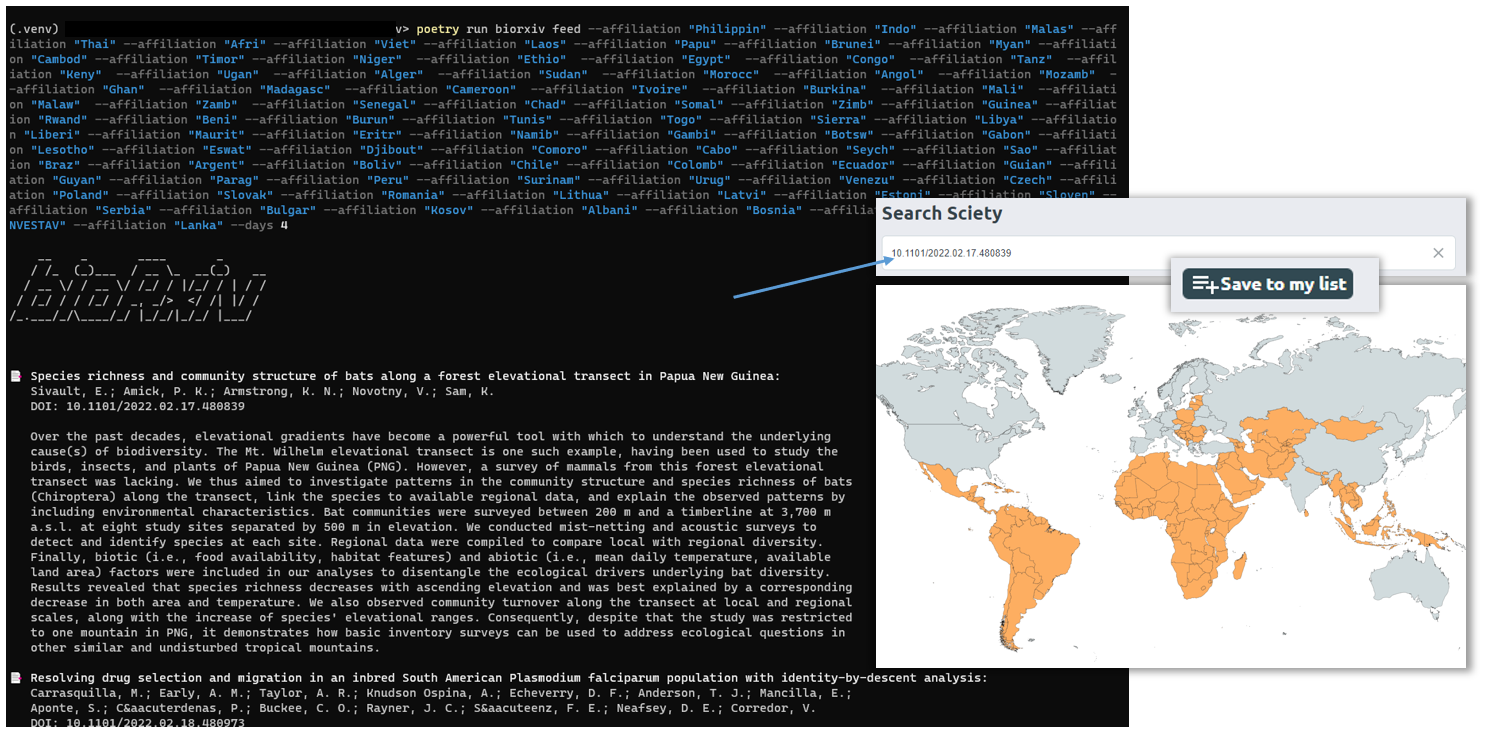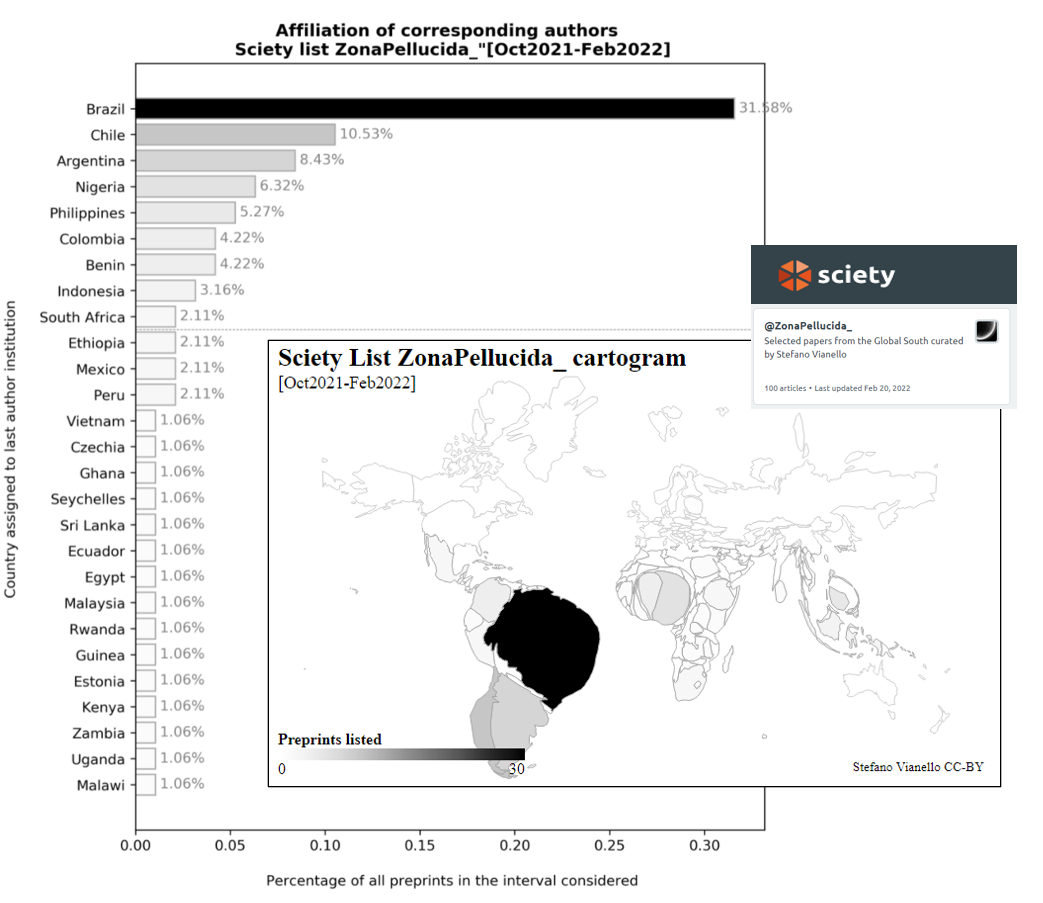100 preprints from around the world
Published:
The Sciety list I curate just reached the symbolic milestone of ONE HUNDRED PREPRINTS with the preprint “Every single conidium in Aspergillus fumigatus caspofungin tolerant strains are intrinsically caspofungin tolerant” (by Clara Valero, collaborators, and colleagues at Universidade de Sao Paulo: doi:10.1101/2022.02.17.480978).
One hundred (!). One hundred preprints authored by researchers from the Global South. One hundred preprints authored by researchers from South America, Africa, South-East Asia. One hundred preprints NOT authored by researchers from the United States of America, Canada, Europe, Australia, the Global North.
An archival/curatorial project I carry out within a maybe more political action of “intentional bibliographical sourcing” exploring strategies of epistemic disobedience, Global North de-centering, and status quo sabotage that I discuss in many of my other blogposts (not here though, as I promised myself this would be a more light-hearted one). It’s a list that I started 4 months ago, October 2021, when I turned to eLife’s “public preprint evaluation platform” Sciety to continue a project that I had started years ago on preLights but which I needed to move to a different platform.
In its most superficial aspect, my Sciety list wants to act as centralising hub of preprints published in the Global South. Given that sourcing these preprints from bioRxiv is not that easy to actually do (even after accounting for the fact that bioRxiv is mostly a repository of US preprints) I want my list to allow its followers to “cut out the middleman”, avoid the awkwardness of bioRxiv boolean search functions and the repetitiveness of manual searches, and provide a complete, up-to-date bibliographical source of available South American, African, South-East Asian bioRxiv preprints.
What does the behind the scenes of all of this looks like? What does a “day in the life” look like? Well, it looks like the terminal window below. Every day, I launch an API query to bioRxiv and supply it with the list of countries I am interested in (in orange in the map1, you will see this list includes Eastern Europe and the Middle-East, which I however do not include yet in my Sciety list). My brother (thank you!) coded me a nice interface where this query outputs the preprint title, the author list, the DOI, and the abstract of every match. Every bioRxiv preprint for which the corresponding author is affiliated with a University whose name includes any of the countries listed (this is as much as I can do for now within the constraints of the metadata). I note down the DOIs, double-check author affiliation on bioRxiv, and when these DOIs are listed on Sciety a few days later, I finally add them to my growing list.
So what kind of content can you expect by following my Sciety feed? It’s the time for some numbers, plotting, and maps.
A preprint landscape clearly dominated by Brazil, Chile, and Argentina, but refreshingly different than many of the bibliographical maps we are accustomed to see when working within Western Academia (see my previous blogpost). I look forward to future Sciety developments on the number and types of indexed preprint servers to enrich these maps.
Finally, and to celebrate this small milestone of 100 preprints, some of my personal highlights.
🔵 My favourite preprint (does my DevBio bias show too much?).
Sandoval, Lisette, et al. “Sonic hedgehog is basolaterally sorted from the TGN and transcytosed to the apical domain involving Dispatched-1 at Rab11-ARE.” bioRxiv (2021). [doi:10.1101/2021.11.10.468081]
🔵 A listed preprint that is now also accompanied by post-publication peer-review from PREreview (notice how Sciety collects all activities connected to the same preprint).
Hwang, Chae Yeon, et al. “Assessment of Agaricus bisporus Mushroom as Protective Agent Against Ultraviolet Exposure.” bioRxiv (2021). [doi:10.1101/2021.10.21.465111]
🔵A preprint touching on traditional medicine, indigenous knowledge, local naming.
Muhongo, Mariah Ndilimeke, Mourine Kangogo, and Christine Bii. “The Antimicrobial Activity of Pechuel-Loeschea leubnitziae Leaf Extract and its Effect on The Expression Level of Methicillin Resistant Staphylococcus Aureus and Candida albicans Virulence-Associated Genes.” bioRxiv (2022). [doi:10.1101/2022.01.11.475881]
I keep returning to this Trouillot quote.
— “Silences enter the process of historical production at four crucial moments: the moment of fact creation (the making of sources); the moment of fact assembly (the making of archives); the moment of fact retrieval (the making of narratives); and the moment of retrospective significance (the making of history in the final instance).” Michel-Rolph Trouillot2
Although there are important considerations to be made on what I call the “preprint axiology”, the assignment of “value”, the evaluation, the implicit and explicit criteria that inform what preprints we consider worthy of reading and which preprints we read (i.e. their “retroscpective significance”), I would like my Sciety list to act to counter Western Academic silences in two of the other two stages: the moments of fact assembly (the making of archives, lists, collections of preprints) and the moment of fact retrieval (the access, and selection of preprints from these archives).

This work is licensed under a Creative Commons Attribution-ShareAlike 4.0 International License. The header banner image is by Eran Menashri on Unsplash.
These blogposts are written in my personal capacity. The views and opinions expressed here are my own. They do not necessarily reflect the views of my University, my Lab, PI, colleagues, or those of the members of any association or society I am affiliated with. .










